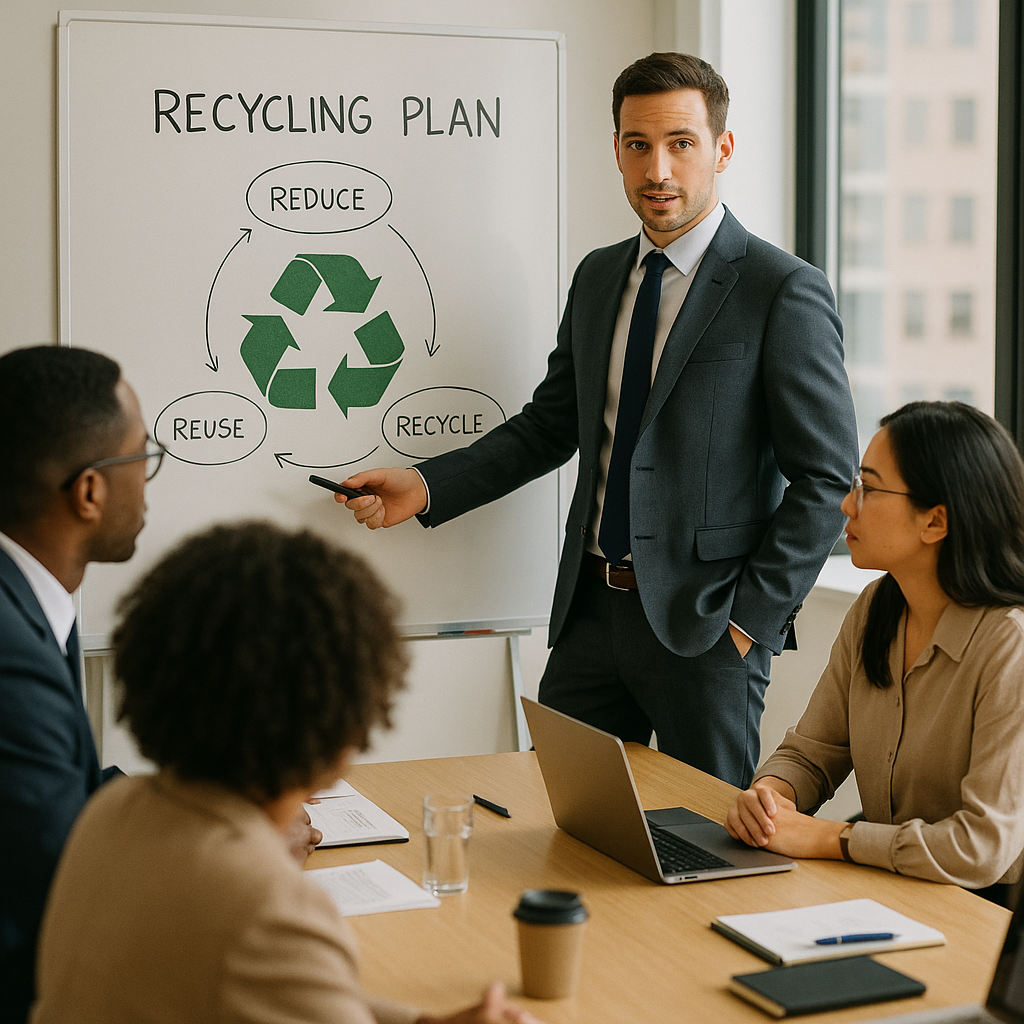5901 Botham Jean Blvd, Dallas, TX 75215
What Are Business Recycling Programs?
July 3, 2025Business recycling programs are structured initiatives designed to efficiently collect, sort, and process recyclable materials in commercial environments. These programs redirect valuable resources like paper, cardboard, plastics, glass, and metals away from landfills. For companies aiming to minimize their environmental impact, recycling programs offer a practical solution that supports broader sustainability goals.
The implementation of business recycling programs has grown increasingly crucial as regulatory requirements tighten and consumer expectations evolve. Many municipalities now mandate commercial recycling, making these programs not just environmentally responsible but also legally necessary. Organizations of all sizes are recognizing that proper waste management is a vital component of responsible business operations.
Effective business recycling programs typically involve partnerships with specialized recycling service providers. These collaborations result in customized solutions tailored to address specific waste streams, operational constraints, and sustainability objectives. The most successful programs integrate seamlessly into existing workflows, making recycling a natural part of daily operations rather than an afterthought.
What Are the Key Benefits of Implementing a Business Recycling Program?

Implementing a comprehensive recycling program offers substantial benefits beyond environmental stewardship. Companies prioritizing recycling gain competitive advantages through cost savings, enhanced reputation, and operational efficiency. The strategic value of recycling extends from immediate financial gains to long-term brand positioning.
Cost Reduction and Revenue Generation
The financial benefits of recycling programs are direct and measurable. Well-designed initiatives reduce waste management costs and can potentially create new revenue streams. This dual impact makes recycling a sound business decision.
- Lower disposal costs: Recycling typically costs less than landfill disposal. UK businesses can save an estimated £23 billion annually through efficient resource use and recycling practices.
- Revenue from recyclables: Materials like aluminum, cardboard, and certain plastics can be sold to recyclers, generating income from otherwise discarded items.
- Reduced procurement expenses: Businesses that incorporate recycled materials into their operations often pay less than for virgin materials.
Recycling creates tangible savings on waste management costs, especially when businesses partner with specialized recycling service providers who can optimize collection systems and ensure regulatory compliance.
Enhanced Brand Reputation and Customer Trust
Consumers increasingly favor businesses that demonstrate environmental responsibility. A visible recycling program signals a commitment to sustainability and can strengthen customer relationships.
Companies with robust recycling programs enjoy improved public perception and consumer loyalty. Environmentally conscious practices resonate with consumers who base purchasing decisions on a company’s sustainability efforts.
Recycling programs also support employee engagement. Staff members take pride in working for organizations that prioritize environmental stewardship, leading to improved morale and retention rates.
Environmental Impact and Energy Conservation
The environmental benefits of business recycling extend beyond waste reduction. Comprehensive programs deliver significant impacts on resource conservation and emissions reduction.
- Energy savings: Recycling aluminum saves up to 92% of the energy required for production from raw materials. Similarly, recycling paper uses 40% less energy than manufacturing from virgin wood pulp.
- Reduced carbon footprint: Global recycling saves over 700 million tonnes in CO2 emissions annually, with projections reaching 1 billion tonnes.
- Natural resource conservation: Each ton of recycled paper saves approximately 20 trees, while recycling one ton of steel preserves 2,500 pounds of iron ore, 1,400 pounds of coal, and 120 pounds of limestone.
Supporting the Circular Economy
Business recycling programs play a crucial role in advancing circular economic principles. Rather than following the traditional take-make-dispose model, recycling keeps valuable materials in circulation, reducing dependence on finite resources.
Implementing recycling programs helps businesses transition from linear production models to circular systems where products and materials maintain their highest utility. This shift supports sustainability while revealing opportunities for product innovation and redesign.
Companies with established recycling programs are better positioned to adapt to changing regulations. As governments worldwide implement stricter waste management policies, businesses with recycling infrastructure in place face fewer compliance challenges.
Compliance and Risk Mitigation
Regulatory requirements for waste management continue to evolve. UK businesses must comply with specific regulations including the Waste Regulations 2011, which mandate prioritizing the waste management hierarchy with recycling over disposal.
The Producer Responsibility Obligations require businesses handling significant packaging materials to ensure proper recycling percentages. Similarly, the WEEE Regulations govern the disposal of electronic equipment.
A structured recycling program helps businesses navigate these requirements, reducing the risk of non-compliance penalties while demonstrating corporate responsibility to stakeholders and regulatory bodies.
How Can Businesses Design an Effective Recycling Program?

Conduct a Waste Audit
Before starting a recycling program, businesses need to understand the waste they generate. A waste audit examines your waste streams to identify the types and quantities of materials being discarded.
A comprehensive waste audit shows which recyclable materials your business produces most. This information helps prioritize which materials to focus on and determines the appropriate container types and sizes needed across your facility.
The audit should examine different areas of your business separately. Production areas, offices, break rooms, and public spaces often produce distinct waste streams, requiring tailored approaches.
Create a Clear Recycling Plan
An effective recycling program requires a structured plan with specific goals. Involve representatives from various parts of your organization during planning.
Your recycling plan should specify the materials to be collected, where collection containers will be located, and who will manage different aspects of the program. Setting measurable goals provides your team with targets to achieve.
Management support is vital for program success. The plan should highlight how recycling will benefit the company through cost savings, better employee morale, and resource conservation.
Evaluate Service Provider Options
Choosing the right recycling service provider is essential. Research available haulers in your area and understand the services they offer.
When meeting potential providers, inquire about the materials they accept, preparation requirements, and collection schedules. Have them visit your facility to assess your needs and propose suitable container solutions.
Carefully review pricing structures. Understand all potential fees, including container rental, pickup charges, and contamination penalties. Some providers may offer revenue sharing for certain valuable recyclables.
Design an Efficient Collection System
The physical setup of your recycling program greatly impacts its effectiveness. Place recycling containers alongside trash receptacles throughout your facility to make recycling as easy as discarding trash.
Use consistent color coding and clear signage on all containers. Blue is commonly used for recycling bins, while trash containers should be a different color. Specific container openings, like round holes for bottles and cans or slots for paper, can help guide proper disposal.
Consider the flow of materials through your facility and identify central collection points where materials can be temporarily stored before pickup by your service provider.
Implement Employee Training and Education
Education is critical to program success. Employees need to understand what materials can be recycled and how to sort them properly.
Create a comprehensive training program that explains recyclable materials. Use visual aids showing accepted items rather than lengthy text descriptions. During the program launch, position volunteers at recycling stations to answer questions and guide proper usage.
Plan for ongoing education as well. New employees need training on the recycling program, and regular reminders help reinforce proper recycling habits for all staff.
Monitor and Optimize Your Program
Regular assessments ensure your recycling program remains effective. Track the volume of materials recycled compared to trash sent to landfill.
Check with your service provider about contamination levels in your recycling. High contamination rates may indicate a need for additional employee training.
Survey employees for feedback on container placement, signage clarity, and potential improvements. This insight helps identify operational issues before they become significant problems.
Conduct follow-up waste audits periodically to measure progress and identify new opportunities for waste reduction.
Ensure Custodial Staff Support
Custodial staff play a crucial role in recycling program success. They must understand the importance of keeping recycling and trash separate during collection.
Provide training specifically for custodial staff about proper handling procedures. Check in regularly to address any challenges they encounter.
If you use contracted cleaning services, ensure recycling procedures are clearly documented in service agreements. Regular communication is important due to high turnover in these positions.
Celebrate and Communicate Success
Track and share your recycling program achievements. Regular updates on progress toward goals help maintain employee engagement.
Consider reporting metrics like pounds of material recycled or the percentage of waste diverted from landfill. These tangible results demonstrate the program’s impact.
Recognize departments or individuals who contribute significantly to recycling efforts. Recognition highlights the program’s importance and encourages continued participation.
What Are Some Common Challenges in Business Recycling?
Recycling Contamination
One of the most significant hurdles businesses face is recycling contamination. This occurs when non-recyclable materials mix with recyclable items. Even small amounts of food residue, plastic bags, or other contaminants can render entire batches of recyclables unusable.
Contamination directly impacts the bottom line. When recycling streams become contaminated, processing costs increase dramatically. Many recycling facilities charge higher rates for contaminated loads or may reject them entirely, forcing businesses to pay premium disposal fees.
The problem extends beyond financial concerns. Contaminated recycling often ends up in landfills despite best intentions, defeating the environmental purpose of recycling programs and wasting resources already invested in collection and transportation.
Employee Participation Challenges
Securing consistent employee participation presents another major challenge. Without buy-in from staff at all levels, even well-designed recycling programs falter. Many employees lack a clear understanding of proper recycling practices specific to their workplace.
Convenience significantly influences participation rates. When recycling bins are poorly located or insufficient in number, employees default to using the nearest disposal option, often leading to recyclable materials ending up in general waste bins.
Maintaining engagement over time requires ongoing effort. Initial enthusiasm for new recycling initiatives typically wanes without regular reinforcement. Businesses must continuously remind and motivate staff to sustain participation beyond the launch phase.
Program Implementation Costs
Setting up an effective recycling program requires upfront investment. Businesses need to purchase collection bins, signage, and potentially specialized equipment depending on their waste stream. These initial costs can be substantial for smaller operations.
Logistical adjustments add another layer of expense. Businesses may need to reconfigure workspace layouts, create storage areas for collected recyclables, or modify existing waste management contracts. These changes require both financial resources and staff time.
The costs continue during operation. Ongoing expenses include maintenance of collection equipment, staff training, and potential premium fees for recycling certain materials. Businesses must weigh these costs against long-term benefits when planning their programs.
Overcoming Recycling Challenges
Clear communication forms the foundation for addressing most recycling challenges. Effective signage with both text and images helps employees quickly identify what goes where. Successful programs use consistent color-coding and simple instructions across all collection points.
Regular education is essential for program success. This includes initial training for all employees plus periodic refreshers. Some businesses find success with designated recycling ambassadors who champion the program and assist colleagues with questions.
Monitoring and continuous improvement keep programs effective. Regular waste audits help identify problem areas and track progress. Businesses should establish feedback mechanisms allowing employees to report issues or suggest improvements. This approach creates a cycle of ongoing refinement that strengthens the recycling program over time.
Conclusion: Embracing Sustainable Business Practices Through Recycling

Business recycling programs are more than just responsible waste management. They are essential for companies looking to enhance sustainability, reduce costs, and minimize environmental impact. A well-designed recycling program provides tangible benefits across various business operations, while also contributing to the broader circular economy.
By implementing recycling initiatives tailored to specific waste streams and operational needs, businesses can succeed in today’s environmentally conscious marketplace. As consumer demand for sustainable practices grows, embracing effective recycling programs is now a strategic necessity rather than a mere corporate responsibility. Though the path to sustainability may present challenges, the environmental, financial, and reputational rewards make it worthwhile for businesses of all sizes.
Ready to transform your waste management approach into a sustainable business advantage? Contact Okon Recycling at 214-717-4083 for customized recycling solutions that align with your business goals and environmental commitments.
